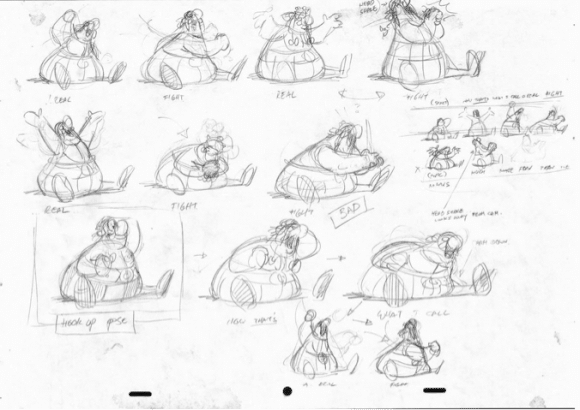About a decade ago, I had the good fortune to read a screenwriting book called How to Write for Animation by Jeffrey Scott. Unlike most screenwriting books, Scott hardly mentions story theory; instead, he focuses on teaching a very practical writing process. I applied his methods in my own work, and was amazed at how helpful they were. In fact, Scott’s book turned out to be one of the three most helpful professional books I’ve read.

Photo by Scott Thomas (Creative Commons)
Here’s the twist though: I wasn’t using it for writing at all! I was an animator—and as it turns out, with just a few minor adjustment Scott’s creative process tips work very well in animation, too.
Does that surprise you? To me, it was a revelation. A book about writing helped me become a better animator; what did that mean? Maybe that creative minds of different art forms have more in common than we usually tend to think. Maybe it means we should all get used to looking beyond the boundaries of our own medium.
What Writers Can Learn from Animators
In this post, I’ll try to go back and suggest three practical writing tips taken straight from the world of animation. I hope to also share with you the sense of wonder that comes from watching two seemingly unrelated things suddenly connect.
1. Act it out
Animators don’t just sit on their little chairs moving drawings or digital puppets around. To really understand their characters, animators act out every scene many times over. They make videos of themselves and study them carefully, looking for small unconscious gestures that reveal mood and personality in an interesting way. They can then weave some of these fine details into their work, adding believability and texture.
Your writing tip: don’t just sit there trying to conjure up interesting actions and dialogues out of thin air. Get up and act out your scenes!
You don’t need to be a great actor; just try to become the character for a little while, and let physical reactions and dialogue happen naturally.
Make a video of yourself doing it, and draw on what you see and hear to create a unique voice and fine texture for your character.
2. Brainstorm key moments with quick snippets
Before starting to animate, animators typically draw multiple thumbnail sketches. These are small, very rough suggestions done in just a few seconds. It allows them to quickly try out many different ideas, then select the ones that have the most appeal or that make the most interesting structure. Here’s an example:

Some of my thumbnail sketches for Asterix and the Vikings
Your writing tip: Instead of writing your outline chronologically, try to identify key moments in the scene and write them as short, quick snippets of action and dialogue. Try out different ways of doing the same thing. Don’t mind the order of things—just write your ideas as they come. Often one key moment would suggest another one—follow the thread and try it out!
Allow yourself to be surprised. Remember that the key is to be QUICK about it. Don’t refine, don’t elaborate, and don’t linger. Try using basic or abbreviated grammar (e.g. “boy opens door—lingers—sigh: not again!”)
Once you feel you have a good overview of the different angles and possibilities the scene has to offer, select a succession of key moments that have the most appeal and the most interesting structure, and use it as a strong starting point for an outline.
3. Let your writing flow through your outline
In animation, “Straight Ahead” is the right-brain process of animating chronologically, one frame after another, no plan – just a pure creative flow. “Pose to Pose” it the left-brain process of drawing the most important poses first, and then connecting them with more drawings.
Sometime in the early 1930’s, Disney animators came up with the method of “animating through poses”. The idea was to plan poses first, then work “Straight Ahead”, gravitating towards the planned poses but not necessarily hitting them exactly. This method is still used by animators to combine left-brain logic with right-brain expressiveness and flow.
Your writing tip: once you have your outline ready, start at the beginning and write “straight ahead” style, letting your right brain lead the way while keeping in mind roughly where you’re headed. Try not to control it too much, just “nudge” it towards the next outline point.
Don’t worry if you’re not writing exactly what the outline indicates; respect the natural flow of your writing, and let happy accidents happen! If the underlying outline is good, it will hold.
Do you have any writing process habits imported from a different discipline?
PRACTICE
Spend ten minutes writing abbreviated “thumbnails” for a short story. Build an outline, then write “straight ahead” through your outline for another ten minutes.
Post your thumbnails and the resulting story in the comments below, and don’t forget to leave some feedback for your fellow writers!
This article is by a guest blogger. Would you like to write for The Write Practice? Check out our guest post guidelines.



I can definitely vouch for point number one. Much like reading your words aloud, acting them out in front of the mirror, and seeing how a real person would say them tends to eliminate unrealistic physical gestures and makes everything more believable. I think writers can learn a lot from movies, including animated ones. 🙂 Great post!
Completely agree. For the longest time, though I did not want to go to a movie because I always started getting an idea from it! But acting out ideas and scenes is a great way to help! Especially for a slow writer like myself.
I don’t act it out so much as write it madly. I just let the characters have their say and figure out how to describe their emotions or actions later. Maybe I envision it the way it ought be acted out.
I do all these things! I sit frowning and gesturing and harrumphing as I write dialogue, putting all the gestures into the scene. When I outline I don’t describe what I *would* write, I just write it, ie, the little flashes which were the inspiration for each scene – and when I have the outline I just write from the start and try to reach the flashes. I was amazed to read these tips, and certainly for me they really work.
The middle one in particular means that you have something solid if small, when you’ve finished your initial outline. Which you don’t, if you just write a brief description of a conversation without including the line which made you think of it in the first place.
-Sef
I really like #2. I am always surprised by what shows up in my doodles! Great post.
I have only a very basic outline when I start, so I’m always surprised by the characters. 🙂 It’s the best part of writing! I also brainstorm key scenes/events and, at least in the privacy of my own home, I act out whole scenes and conversations. So glad to know it’s all okay! 🙂
I agree! Being surprised and moved by your characters is such a wonderful experience.
I love it when the characters surprise me (in animation as well as in writing). That’s when I know the character is really coming to life.
#1 is my natural habit when I get any idea. I just don’t video tape it. I love acting though and I generally place myself as the main character so I act the main characters part, but really enjoy doing every part. I also have journal just for any writing inspiration and I outline my story as well as character charting.
I’ve always been frustrated that the movie playing in my head doesn’t make it onto paper in the same way. It never occurred to me to act it out. While I read dialogue out loud, I’ve never filmed it. Time to access my inner actress. Helpful advice!
Great 🙂 Just remember to have fun with it, it’s not something that needs to be prefect or anything.
I wish I did all these things, and I’ll have to start!! Great tips, and very applicable, for any fiction writer 😀
Thank you, Doron 🙂 What an excellent affirmation of my embarrassing work method! I’m an animator who started writing. I have to brainstorm on paper so I can draw in those story beats, to see if they track emotionally. Attached examples from yesterday… all rights reserved.
This is awesome – you’re really fusing writing and animation together there… Gotta try this myself! Good things always seem to happen when one thinks in more than one medium at a time.
I am a fan of number 2. I think breaking down important scenes help with finding what works and what doesn’t. Even more so since important scenes such as catalysts are complex. http://www.andrecruz.net
Joe I love all three tips but #1 is especially insightful. Thanks!
Awesome tips! Instead of acting scenes out myself, I usually daydream others into the acting processes. it seems to work pretty good too. But I might embarrass myself and trying acting in front of a camera to capture the ideas!
Good post. I won’t go as far as filming myself on the iMac though.
I know reading my writing out loud helps a lot–having someone else (my writing partner) read it out loud helps even more! Amazing how many blips show up!
The one thing that I have always done that is similar to #1 is that I picture an actor that I would chose to play a one of the characters in the movie or stage production of my story in each scene–their voices, their mannerisms, facial expressions, inflections. Doing so helps me keep scenes in sort of a mental story-board sequence.
Interestingly, I see some of these techniques working in my writing to some level or another! I studied animation but I’ve seen a definite improvement in my writing for fiction! And I’m sure it’s because of these points you’ve mentioned!
Great to hear that these are working, Tim! Thanks!
Joe Bunting
joebunting.com
That’s awesome. Thanks for sharing! Also, you might want to check out Alex Orrelle’s comment below (he’s an animation director and a former Pixar animator).